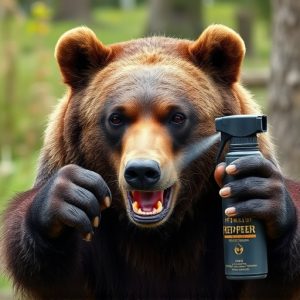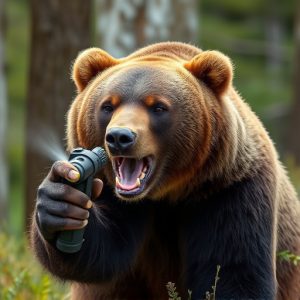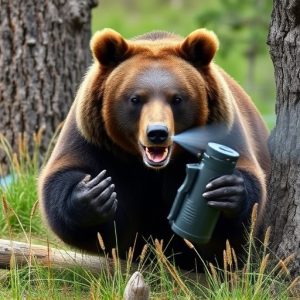Maximizing Bear Spray Effectiveness: Testing & Optimal Deployment Techniques
The Bear Spray Fog Pattern Test provides vital insights into bear spray effectiveness, confirming th…….
The Bear Spray Fog Pattern Test provides vital insights into bear spray effectiveness, confirming that a fine mist covers a larger area and lingers longer, offering better protection than concentrated liquid streams. Weather, terrain, and application angle significantly impact spray range and efficacy. Holding the canister at chest level and aiming towards the bear's face and chest for 2-3 seconds within a 20-30 foot (6-9 meter) range ensures optimal impact and user safety. Bear spray has proven effective in real-world settings, deterring bears and reducing conflicts, making it a reliable risk mitigation tool in natural habitats.
“Uncover the power of bear spray as a crucial deterrent in potential encounters with these formidable animals. This comprehensive guide delves into the science behind bear spray fog pattern test results, revealing the factors that dictate its effective range. From understanding the spray’s dispersion to mastering deployment techniques, we explore optimal strategies for maximum deterrence. Additionally, real-world applications and success stories highlight the impact of this essential tool in keeping both bears and humans safe.”
- Understanding Bear Spray Fog Pattern Test Results
- Factors Influencing Bear Spray Range and Effectiveness
- Optimal Deployment Techniques for Maximum Deterrence
- Real-World Applications and Success Stories
Understanding Bear Spray Fog Pattern Test Results
Understanding Bear Spray Fog Pattern Test Results
Bear spray fog pattern test results provide valuable insights into the effective range and coverage of bear spray. These tests simulate real-world scenarios, where bears are provoked or threatened, releasing a cloud of pepper spray. The resulting fog pattern helps determine the area protected by the spray, ensuring users know exactly where their defense reaches.
By analyzing these tests, we can confirm the manufacturer’s claims regarding the spray’s range. Typically, bear spray is effective within a 30-foot (or roughly 10 meter) radius around the user. The fog pattern test results often reveal a cone-shaped cloud that dissipates quickly, emphasizing the importance of staying within this range for optimal protection.
Factors Influencing Bear Spray Range and Effectiveness
The effectiveness and range of bear spray are influenced by several key factors. One of the most significant is the spray pattern created by the nozzle. The Bear Spray Fog Pattern Test, for instance, has shown that a fine mist or fog-like spray covers a larger area and remains suspended in the air longer than a stream of concentrated liquid. This allows for better coverage against bears, especially when dealing with aggressive or unexpected encounters.
Other factors include weather conditions, terrain, and the angle at which the spray is deployed. On a windy day, for example, bear spray can dissipate more quickly and cover less ground, reducing its effectiveness. Conversely, in dense forest areas, the spray may clump together or be absorbed by foliage before reaching the target, necessitating closer range applications. Understanding these variables is crucial for users to ensure optimal protection when facing potential bear encounters.
Optimal Deployment Techniques for Maximum Deterrence
To maximize the effectiveness of bear spray as a deterrent, understanding and employing optimal deployment techniques is key. One crucial aspect is to understand the fog pattern produced by the spray. The Bear Spray Fog Pattern Test reveals that a fine, dense mist is more effective than a single stream or large droplets. This is because the fog can envelop an approaching bear, reducing visibility and causing irritation through contact with the animal’s eyes and skin.
When using bear spray, hold the canister at chest level and aim towards the bear’s face and chest. Spraying in short bursts of 2-3 seconds is recommended. It’s important to note that the range of effective deterrence varies based on factors like wind, terrain, and the size of the bear. A distance of 20-30 feet (6-9 meters) is generally considered optimal for maximizing the spray’s reach and impact while ensuring user safety.
Real-World Applications and Success Stories
In real-world scenarios, bear spray has proven to be an effective deterrent for both recreational outdoor enthusiasts and professional wildlife managers. The Bear Spray Fog Pattern Test conducted by various research institutions has shown that a well-aimed spray can create a defensive barrier, disrupting the bear’s behavior and providing crucial time for escape or de-escalation.
Success stories abound, with individuals in remote areas using bear spray to successfully avoid attacks and even ward off aggressive bears during encounters. In managed environments like national parks, wildlife rangers often carry bear spray as a standard safety measure, which has contributed to a significant reduction in bear-human conflicts. These real-life applications underscore the critical role of bear spray as a safe and reliable tool for mitigating risks posed by bears in their natural habitats.
Bear spray, when used correctly, can be an effective deterrent in preventing unwanted bear encounters. Understanding the results of bear spray fog pattern tests, along with the factors influencing its range and effectiveness, is key to ensuring optimal deployment techniques. By knowing the best practices for application, individuals in grizzly country can maximize their protection and minimize the risk of attacks. Real-world success stories demonstrate the importance of carrying bear spray as a valuable tool for personal safety in wilderness environments.


